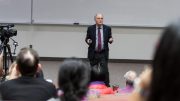How is it that birds, those tiny feathery creatures, were precisely navigating the globe while hominids had not yet managed to efficiently communicate directional information?
Why is it that bees, seemingly mindless hive animals, can solve complicated mathematical operations that strain the best of our computers?
Quantum entanglement may hold the answer to both of these questions. In recent studies on animal navigation, the theory of quantum entanglement has been used to explain complicated animal behaviour in seemingly simple animals.
Quantum entanglement is part of the larger quantum theory of physics, which departs considerably from the “classical” behaviour of electrons. Atoms and sub-atomic particles, instead of being units with their own (discrete and arbitrary) kinetic energy, are better conceptualized as wave-like and existing in a cloud of possible places.
This theory is best characterized with Bohr’s electron model. We all know Bohr from the boring atomic sketches (as well as all that nonsense about discrete energy levels in the orbitals), but did you know that the orbit of a Bohr-model electron is denoting at once uncertainty in the universe and a wave-particle duality of the very pieces that compose an electron?
Bohr’s model explains that “electrons that orbit around the nucleus interact with each other by showing interference patterns, not unlike those of wave interference. If the velocity of the electron is thought of as its wavelength, the crests of neighbouring electron waves amplify or cancel each other, thereby creating a pattern that corresponds to Bohr’s allowed orbits.” As for the reason that the electrons stay at certain discrete energy levels?
The answer lies in Planck’s theory of quantized energy, or quanta. Quanta are the units that energy is made of, much like subatomic particles making up an atom. This energy can only be transferred in discrete units (quanta), which are a multiple of the Planck constant. Certain objects can occupy a minimum quantum-energy level, as opposed to the classical physics notion that objects at rest have zero kinetic energy.
That’s not where the theory gets strange, though. Thebigview.com writes, “[In quantum mechanics] the observer is no longer external and neutral, but through the act of measurement he becomes himself a part of observed reality.” In other words, by simply observing, you irreversibly alter the results. This phenomenon, although strange, can be explained by quantum entanglement.
Erwin Schrodinger offered a concise explanation of the phenomenon in a 1935 paper: “When two systems, of which we know the states by their respective representatives, enter into temporary physical interaction due to known forces between them, and when after a time of mutual influence the systems separate again, then they can no longer be described in the same way as before, viz. by endowing each of them with a representative of its own. I would not call that one but rather the characteristic trait of quantum mechanics, the one that enforces its entire departure from classical lines of thought.” In other words, electrons that are physically separated can influence each other.
So far, we have only been able to create a state of quantum entanglement in the laboratory, and only for extremely short periods of time. Quantum states were first thought to be attainable only in extremely specific, usually low-temperature environments, where “atoms are cooled to near-absolute-zero temperatures to maintain entanglement for [ . . . ] a few thousandths of a second.”
A special intricate molecule has been developed that can maintain quantum states at room temperature for four fifths of a second. In an article for Wired.com, physicist Simon Benjamin of Oxford University explains that “the molecule called N@C60 [is] a geometric cage of carbon with a nitrogen atom inside. This molecule is one of the best-known laboratory systems for maintaining entanglement. ‘The cage acts to shield the atom, which is storing the information, from the rest of the world.’”
Birds apparently need no special environment to access quantum information and use quantum entanglement for navigation. Benjamin discovered the existence of special quantum cells in the bird’s eye. The cells, containing a protein called cryptochrome, are thought to be able to sense the earth’s magnetic field by use of quantum entanglement.
According to Wired.com: “When a photon enters the eye, it hits cryptochrome, giving a boost of energy to electrons that exist in a state of quantum entanglement. One of the electrons migrates a few nanometers away, where it feels a slightly different magnetic field than its partner. Depending on how the magnetic field alters the electron’s spin, different chemical reactions are produced. In theory, the products of many such reactions across a bird’s eye could create a picture of Earth’s magnetic field as a varying pattern of light and dark.”
To test whether birds were indeed quantum-sensitive, “researchers led by University of California, Irvine physicist Thorsten Ritz showed in 2004 that although robins had no trouble pointing their beaks toward Africa under the influence of Earth’s magnetic field alone, adding a second, shifting field destroyed their inner compasses. That second field was so weak — less than one-third of one percent of Earth’s field — that it could only have influenced a quantum-sensitive system.”
Birds aren’t the only place quantum theory has been popping up in the natural world. Bees and green plants are thought to work on quantum principles.
Photosynthesis hinges on the efficient transfer of energy, which at its core may be facilitated by a quantum entangled set of electrons. ScienceDaily.com writes, “Graham Fleming, a physical chemist holding joint appointments with Berkeley Lab and UC Berkeley, pointed to quantum mechanical effects as the key to the ability of green plants, through photosynthesis, to almost instantaneously transfer solar energy from molecules in light harvesting complexes to molecules in electrochemical reaction centres.” The study finds that a pair of entangled electrons may be able to transfer their energy states, one to the other, without the need for a loss-inducing chemical or biological method of energy transfer.
The findings are thought to hold many serious implications in the construction of future solar panels as well as advancing the progress to the creation of a quantum computer.
It would be no surprise then that the greatest friend to flowering plants is also able to interact with the world on a quantum level.
Barbara Shipman, a biologist and mathematician, has found some interesting correlations between bee communication and the mathematics used to describe the workings of quarks, the “building blocks of protons and neutrons,” writes Adam Frank in an article for Neuroquantology.com. As we are all probably aware, bees communicate the location of a food source using an intricate dance that conveys complex geographic information. Though scientists have long known and studied bee communication, there has been little progress made in deciphering how the animals obtain and store so much information. Shipman, who studied both bees and math, thinks she may have the answer.
The shape of the bees “dance” is almost exactly like the shapes used to represent the quantum fields that unobserved quarks create. Shipman discovered this when she was projecting a shape known as a “flag manifold,” most often used to represent the states of quarks, onto two-dimensional space. The shape reminded her of the outline of the bees peculiar dances, and she theorizes that the bees may be using quantum fields to navigate, as opposed to magnetism, as the previous theory suggested.
Further evidence to quantum sensitivity in bees is provided by their ability to solve the notoriously hard “travelling salesman” problem. The problem involves a salesman travelling to numerous cities; the desired solution is to find the shortest path between them. It’s a useful analogy for the process of finding the shortest path between a series of mathematical points, and it’s one of the hardest computational problems in existence. A bee, while flying past flowers, “sees” them in the wrong order. The animal is quickly able to learn and take the quickest path between them, thereby solving the mathematical problem. A modern computer, faced with the same dilemma, can take days to figure out the shortest path between multiple points.
Although quantum mechanics may have started as a way to describe laboratory systems and solve theoretical problems, it’s apparently alive and well in the natural world. It’s a humbling notion that some of the earlier inhabitants of the planet have integrated our furthest edge of understanding into their modes of life. Another question immediately comes to mind: If we have been around so long, and only now do we realize the intricacies of our surroundings, what else will we find with the development of new theories and modes of thought?





Everybody should be fully aware of the unforgivable disservice that conventional reductionist science, by burying its head in the sand, has done to generations of bright new students, forced to follow conventional, administrative dogma.
One hopes that having been forced into accepting quantum reality, that has been fully known for 80 years, by the threat to cryptology, “science” moves on with an open, enquiring, bias free attitude in all areas of research.